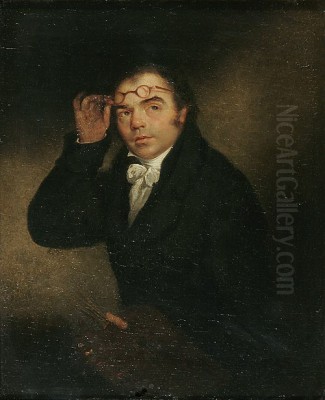
John Crome, often affectionately known as "Old Crome" to distinguish him from his artist son, stands as a pivotal figure in the history of British art. Born in Norwich in 1768 and passing away in the same city in 1821, Crome was a leading landscape painter of the English Romantic period. He is most renowned as the principal founder and guiding spirit of the Norwich School of painters, the first significant art movement to emerge in Britain outside of London. His work, deeply rooted in the observation of his native Norfolk countryside, combined a profound respect for Dutch Golden Age masters with a distinctly English sensibility, capturing the subtle beauties of light, atmosphere, and rural life.
Early Life and Artistic Formation
John Crome's origins were humble. Born into poverty as the son of a journeyman weaver, his early life offered few prospects for formal education or artistic training. He began his working life young, serving as an errand boy for a local doctor. At the age of twelve, he was apprenticed to Francis Whissler, a coach, house, and sign painter in Norwich. This apprenticeship, while practical, provided Crome with foundational skills in handling paints and brushes, and perhaps more importantly, it placed him within a trade connected, however distantly, to the visual arts.
During his apprenticeship and the years immediately following its completion, Crome dedicated his spare time to sketching and drawing directly from nature. He formed a close childhood friendship with Robert Ladbrooke, who shared his burgeoning passion for art. Together, they would venture into the fields and along the rivers surrounding Norwich, sketching landscapes and honing their observational skills. They reportedly shared a small attic space, purchasing prints to copy and learn from. This period of self-directed study was crucial in shaping Crome's artistic path.
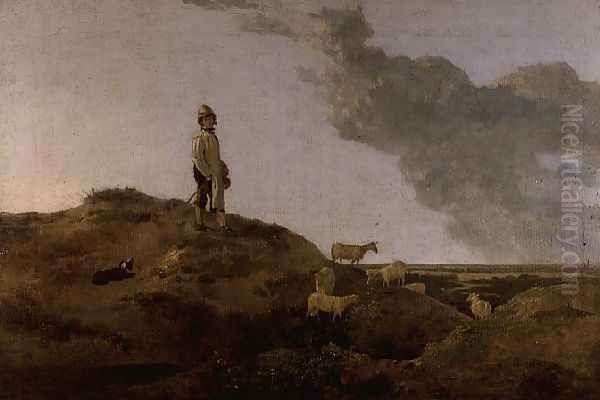
A significant turning point came through his acquaintance with Thomas Harvey of Old Catton, a wealthy collector and amateur artist. Harvey recognized Crome's potential and granted him access to his impressive art collection, which included works by Dutch masters such as Meindert Hobbema and Jacob van Ruisdael, as well as paintings by the influential British landscape artists Thomas Gainsborough and Richard Wilson. Studying these works firsthand was Crome's real art education; he learned by copying and absorbing the techniques, compositions, and atmospheric effects of these masters. Harvey's patronage provided not just inspiration but also valuable connections.
Through Harvey, Crome likely met Sir William Beechey, a successful portrait painter with connections to the London art world. Beechey offered encouragement and practical advice, further aiding Crome's development. Crome also received some instruction from the Cornish-born painter John Opie, known for his portraits and historical scenes but also an accomplished painter in his own right, with whom Crome maintained a lasting friendship. These interactions, combined with his relentless self-study and observation of nature, allowed Crome to transcend his sign-painting origins and emerge as a serious landscape artist. He began to support himself by taking on pupils, becoming a respected drawing master for prominent Norwich families.
The Norwich Society of Artists
Crome's ambition extended beyond his personal artistic practice. He envisioned a community where local artists could exhibit their work, exchange ideas, and foster a regional artistic identity. In 1803, alongside his friend Robert Ladbrooke and other local artists, including John Sell Cotman (though Cotman's involvement was more intermittent initially), James Stark, and George Vincent (who would later become his pupils), Crome formally established the Norwich Society of Artists.
This was a groundbreaking initiative. It represented the first art society founded in the British provinces with the aim of holding regular exhibitions. The Society provided a vital platform for artists working outside the dominant London scene, fostering a sense of shared purpose and mutual support. Their first exhibition was held in 1805 in Sir Benjamin Wrench's Court, a large room that became their regular venue. These annual exhibitions became important local events, showcasing the burgeoning talent within the region.
John Crome was the Society's driving force and natural leader. He served as its president for several terms, guiding its activities and contributing significantly to its exhibitions year after year. His dedication helped solidify the Society's reputation and laid the groundwork for what would become known as the Norwich School. The School wasn't a formal academy but rather a group of artists linked by geography, shared influences (particularly Dutch 17th-century landscapes), and a common focus on depicting the local scenery of Norfolk with truthfulness and atmospheric sensitivity.
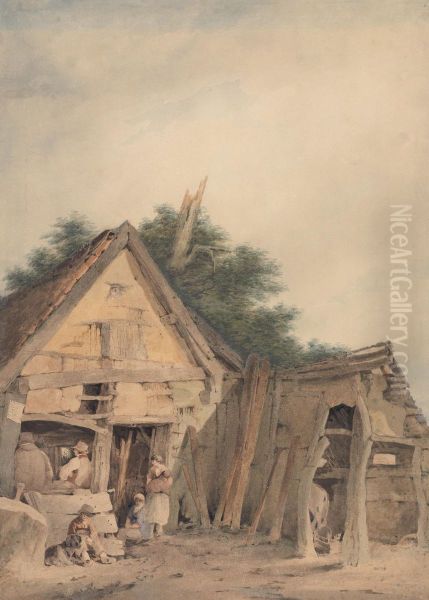
The Society was not without its internal tensions. Around 1816, a disagreement, possibly over the direction or management of the society, led to Crome and Ladbrooke temporarily parting ways, with Ladbrooke forming a splinter group. However, this division was relatively short-lived, and the Norwich Society continued to thrive, holding exhibitions until 1825, and then, after a brief hiatus and reorganization, continuing as the "Norfolk and Suffolk Institution for the Promotion of the Fine Arts" until 1833. Crome remained central to the original society until his death in 1821.
Artistic Style and Influences
John Crome's artistic style is characterized by its directness, its profound connection to the Norfolk landscape, and its masterful synthesis of observation and painterly technique. While deeply influenced by the Dutch landscape tradition, particularly the works of Meindert Hobbema and Jacob van Ruisdael, Crome developed a distinctly personal and recognizably English approach. He admired the Dutch masters for their unpretentious realism, their skillful rendering of trees and skies, and their ability to capture specific qualities of light and atmosphere.
From Hobbema, Crome learned how to depict the intricate textures of foliage and the play of sunlight through leaves. From Ruisdael, he absorbed lessons in composing dramatic skies and conveying the weight and solidity of the natural world. The influence of Aelbert Cuyp can also be seen in the warm, luminous quality of light found in some of Crome's works. He also studied the work of British predecessors like Thomas Gainsborough, particularly his earlier, more Dutch-influenced landscapes, and Richard Wilson, whose classical compositions and sensitivity to light provided another important model.
However, Crome was no mere imitator. He translated these influences into his own visual language, one perfectly suited to the gentle, rolling countryside, meandering rivers, heathlands, and expansive skies of Norfolk. His compositions are often simple and direct, focusing on specific motifs – a gnarled oak tree, a quiet stretch of river, a windmill silhouetted against the sky, the rustic buildings of a farm or village. He possessed a remarkable ability to capture the 'genius loci', the spirit of a particular place.
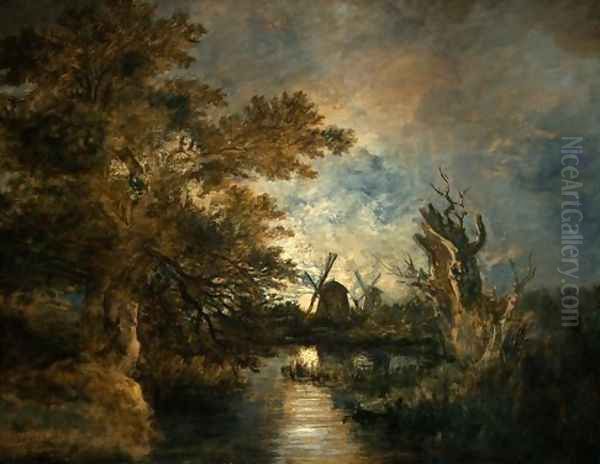
Crome worked with a robust, often broad handling of paint, yet he achieved great subtlety in his depiction of light and atmosphere. His palette, while sometimes featuring the silvery tones noted by critics, could also be rich and earthy. He excelled at rendering the changing conditions of weather and time of day – the cool light of early morning, the golden glow of sunset, the pearly luminescence of a moonlit night. Some contemporaries found his work lacking 'finish', but this very quality – a certain ruggedness and honesty in the brushwork – is now seen as a strength, anticipating later developments in landscape painting. His approach marked a transition from the more formalized topographical traditions of the 18th century towards the more personal, expressive, and atmospheric concerns of Romanticism.
Masterworks and Subjects
John Crome's output, while not as vast as that of some contemporaries like J.M.W. Turner or John Constable, includes a significant body of work that encapsulates his artistic vision. His subjects were drawn almost exclusively from the area around Norwich, a landscape he knew intimately and loved deeply. He rarely ventured far, although a trip to Paris in 1814, following Napoleon's defeat, resulted in some paintings based on French subjects, though these are less typical of his oeuvre.
Among his most celebrated oil paintings is Mousehold Heath, Norwich (several versions exist, including one in the National Gallery, London). This subject, a large area of heathland overlooking the city, was one Crome returned to repeatedly. These works capture the vastness of the sky and the rugged texture of the land, often imbued with a sense of quiet grandeur and solitude. They exemplify his ability to find beauty and significance in seemingly ordinary local scenes.
The Slate Quarries (Tate Britain) is another powerful work, likely inspired by scenery encountered on a trip to the Lake District, although debated. It shows a more dramatic side of Crome's art, with its strong composition and atmospheric depth, demonstrating his versatility beyond the gentle Norfolk landscape. Moonrise on the Yare (or similar titles referring to the River Yare) showcases his skill in nocturnal scenes, capturing the subtle effects of moonlight on water and land with remarkable sensitivity.
Other key works include View of Carrow Abbey near Norwich (Norwich Castle Museum), depicting the picturesque ruins with a quiet dignity, and Windmill on the Yare (or variations like A Windmill near Norwich), celebrating a characteristic feature of the Norfolk landscape. The Poringland Oak (National Gallery, London) is a magnificent study of a single, ancient tree, demonstrating his profound understanding and appreciation of natural forms, clearly showing the influence of Hobbema. Chapel-Fields, Norwich (Tate Britain) depicts a scene of local life and leisure within a carefully structured landscape setting.
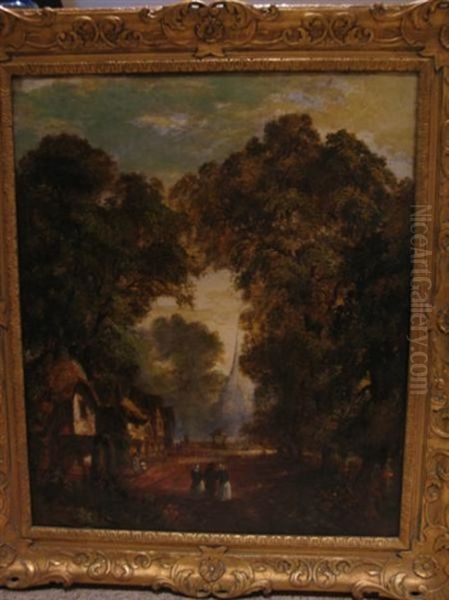
Beyond oil painting, Crome was also a master etcher. Although he did not publish his plates during his lifetime, a collection titled Norfolk Picturesque Scenery was issued posthumously by his widow in 1834, with later editions following. These etchings, often based on his drawings and paintings, display the same directness, strong composition, and sensitivity to light and texture found in his oils. They further cemented his reputation and disseminated his vision of the Norfolk landscape.
Teaching and Legacy
John Crome's influence extended significantly through his role as a teacher. For many years, he earned a substantial part of his income by giving drawing lessons to the children of affluent Norwich families. This activity not only provided financial stability but also allowed him to disseminate his artistic principles and techniques to a younger generation.
His most important pupils were those who became core members of the Norwich School, carrying forward its ideals after his death. Among these were James Stark and George Vincent, both of whom achieved considerable success as landscape painters in their own right, exhibiting regularly in London as well as Norwich. Their work clearly shows Crome's influence in its subject matter and naturalistic approach, though each developed his own distinct style.
Crome's most prominent artistic heir was his eldest son, John Bernay Crome (1794-1842). Also a landscape painter, J.B. Crome worked in a style closely related to his father's, often favouring moonlight and coastal scenes. He became a leading figure in the Norwich Society after his father's death. The similarity in their styles and subject matter, combined with the fact that both signed their works "J. Crome," has historically led to confusion and misattribution, sometimes making it difficult to distinguish the father's work from the son's, particularly J.B. Crome's earlier pieces. This confusion occasionally complicated the assessment of "Old Crome's" unique contribution.
The Norwich School itself, largely shaped by Crome's vision and leadership, represents his most enduring legacy. It fostered a remarkable concentration of artistic talent in a provincial city, producing painters like John Sell Cotman (whose brilliant, more stylised work offers a fascinating contrast to Crome's naturalism), Miles Edmund Cotman (J.S. Cotman's son), Reverend Edward Thomas Daniell, and others. The school's emphasis on direct observation, local subjects, and atmospheric truthfulness had a lasting impact, and some historians have suggested its realist tendencies may have influenced the later Barbizon School in France, though this connection is debated. Crome's dedication to his pupils and his role in founding the Society ensured that his artistic values would continue to resonate long after his passing.
Connections and Contemporaries
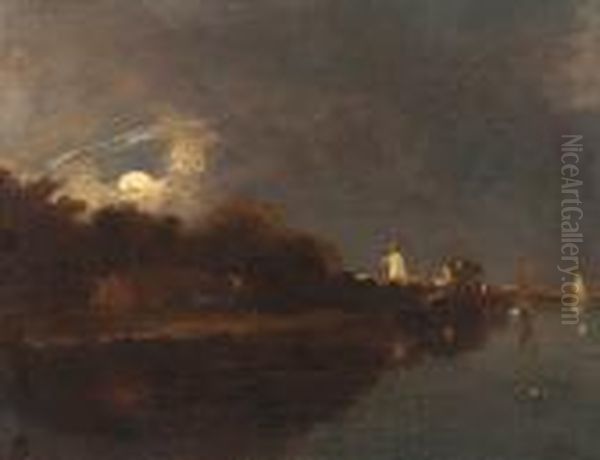
Throughout his career, John Crome maintained connections with various figures in the art world, both locally and, to a lesser extent, nationally. His lifelong friendship and early artistic partnership with Robert Ladbrooke were foundational, even though they later experienced a period of rivalry. His relationship with patrons like Thomas Harvey was crucial for his early development, providing access to influential art and connections.
His interactions with established London artists like Sir William Beechey and John Opie provided valuable guidance and professional validation. While primarily based in Norwich, Crome did exhibit occasionally at the Royal Academy in London, starting in 1806, bringing his work to a wider, though perhaps less consistently appreciative, audience. He exhibited a total of 14 works there over his lifetime.
Within the Norwich School, he was the central figure, influencing and collaborating with artists like James Stark, George Vincent, and his son John Bernay Crome. He also knew and worked alongside John Sell Cotman, the other major figure of the Norwich School, whose artistic path, while intersecting with Crome's, ultimately led in a different, more graphically stylized direction.
When considering Crome's place among his national contemporaries, he stands somewhat apart from the dominant figures of London-based Romantic landscape painting. While sharing a love for nature with John Constable and J.M.W. Turner, Crome's approach was generally quieter, less overtly dramatic than Turner's, and less focused on the transient effects of weather than Constable's later work. His deep engagement with the Dutch tradition, shared to some extent by Constable but less central to Turner, also distinguishes him. He admired the work of fellow landscape painter James Ward, known for his animal studies and dramatic scenes. Compared to these giants, Crome's output was smaller, and his national reputation during his lifetime was considerably less prominent, partly due to his provincial base and perhaps his more reserved artistic temperament.
Challenges and Recognition
Despite his local renown and pivotal role in the Norwich School, John Crome's career was not without challenges. His humble background meant he lacked the social advantages and formal training enjoyed by some contemporaries. While he achieved success as a drawing master, his income from painting sales appears to have been inconsistent, and he faced financial difficulties throughout his life. Evidence suggests he died in debt in 1821, following a short illness possibly exacerbated by attending an exhibition opening while unwell.
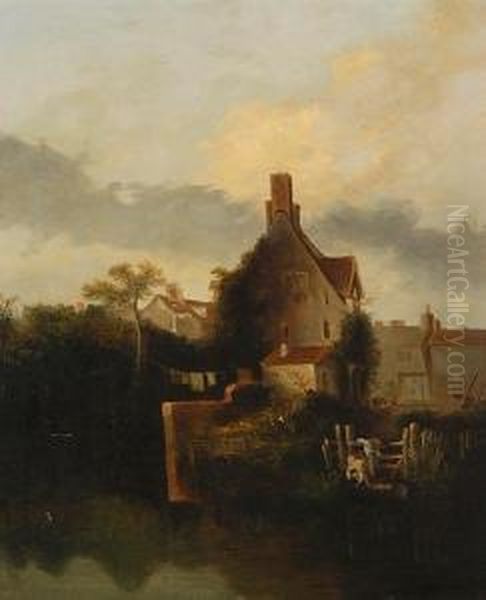
His decision to remain based in Norwich, while fostering a strong regional school, limited his exposure to the lucrative London art market and the critical discourse centered there. Consequently, his national reputation grew slowly. Furthermore, the very nature of his style, deeply indebted to 17th-century Dutch masters like Hobbema and Ruisdael, sometimes led to his works being dismissed as derivative or even misattributed. The problem of authenticity has persisted, compounded by his relatively small output, the existence of numerous copies and imitations, and the confusion with the work of his son, John Bernay Crome.
Crome was also known to be an avid collector himself, particularly of Dutch paintings, a passion likely fueled by his early exposure through Thomas Harvey. Anecdotes suggest he once contemplated selling his collection but was dissuaded by his family, highlighting the complex interplay between his artistic practice, his connoisseurship, and his personal life.
Posthumous recognition, however, gradually increased. The publication of his etchings in 1834 helped disseminate his work. His paintings began to command higher prices later in the 19th century, particularly after being featured prominently in major exhibitions, such as the 1862 International Exhibition in London. Critics in the late 19th and early 20th centuries, including figures like Clive Bell (who reportedly ranked him with Constable and Turner) and possibly Henry James (though specific quotes require verification), began to reassess his contribution, recognizing the unique strength and sincerity of his vision. He came to be seen not just as a provincial master but as a key figure in the broader story of British landscape painting.
Crome's Place in Art History
John Crome occupies a unique and significant place in British art history. He was, first and foremost, the heart and soul of the Norwich School, demonstrating that artistic innovation and excellence could flourish outside the metropolis. His commitment to depicting his local environment with honesty and sensitivity set a powerful example for his followers and contributed to the growing appreciation for native scenery in British art.
His deep engagement with the Dutch landscape tradition was not merely imitative but transformative. He absorbed the lessons of Hobbema, Ruisdael, and Cuyp regarding composition, light, and texture, but applied them to the specificities of the Norfolk landscape, creating works that felt both timeless and deeply rooted in place. In this, he acted as a vital bridge, connecting the great European landscape traditions of the past with the emerging Romantic sensibilities of his own time.
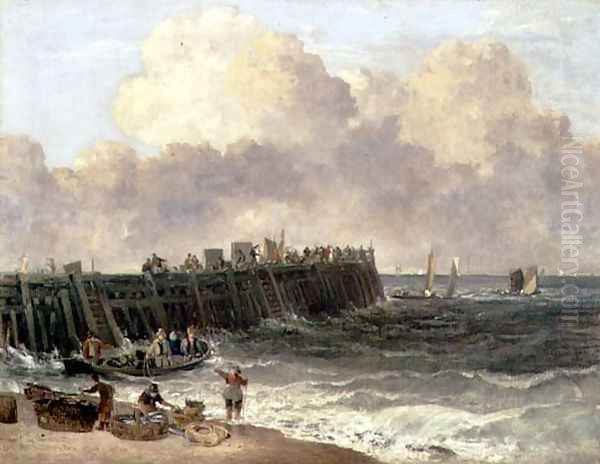
While perhaps overshadowed during his lifetime and for some time after by the more revolutionary talents of Constable and Turner, Crome's achievement is now widely recognized. He is celebrated for the quiet integrity of his vision, the robustness of his technique, and his ability to convey profound feeling through the straightforward depiction of nature. His focus on the structure and substance of the landscape, combined with his mastery of atmosphere, gives his best works an enduring power.
Often described as a "forgotten genius" whose true stature is only periodically rediscovered, Crome remains a testament to the importance of regional art movements and the value of sustained, intimate observation of one's surroundings. His work continues to resonate with viewers who appreciate subtle beauty, painterly honesty, and the deep connection between an artist and his native land. He stands as a master of the English landscape, a crucial figure in the Norwich School, and an artist whose quiet dedication produced works of lasting significance.
Conclusion
John Crome's journey from a weaver's son and sign painter's apprentice to the founder of the Norwich School and a master of English landscape painting is a remarkable story of talent and perseverance. Rooted in the Norfolk countryside, his art synthesized the profound influence of Dutch Golden Age painters with a direct, honest observation of his native environment. Through his leadership of the Norwich Society of Artists and his role as a teacher, he fostered a vibrant regional art movement and influenced a generation of painters, including his son John Bernay Crome, James Stark, and George Vincent. Despite facing financial challenges and achieving only limited national fame during his lifetime, Crome's reputation has steadily grown. Today, his works, celebrated for their atmospheric depth, robust technique, and quiet dignity, secure his position as a pivotal figure in the development of British Romantic landscape painting. "Old Crome" remains an essential artist for understanding the richness and diversity of art in Britain during the early nineteenth century.